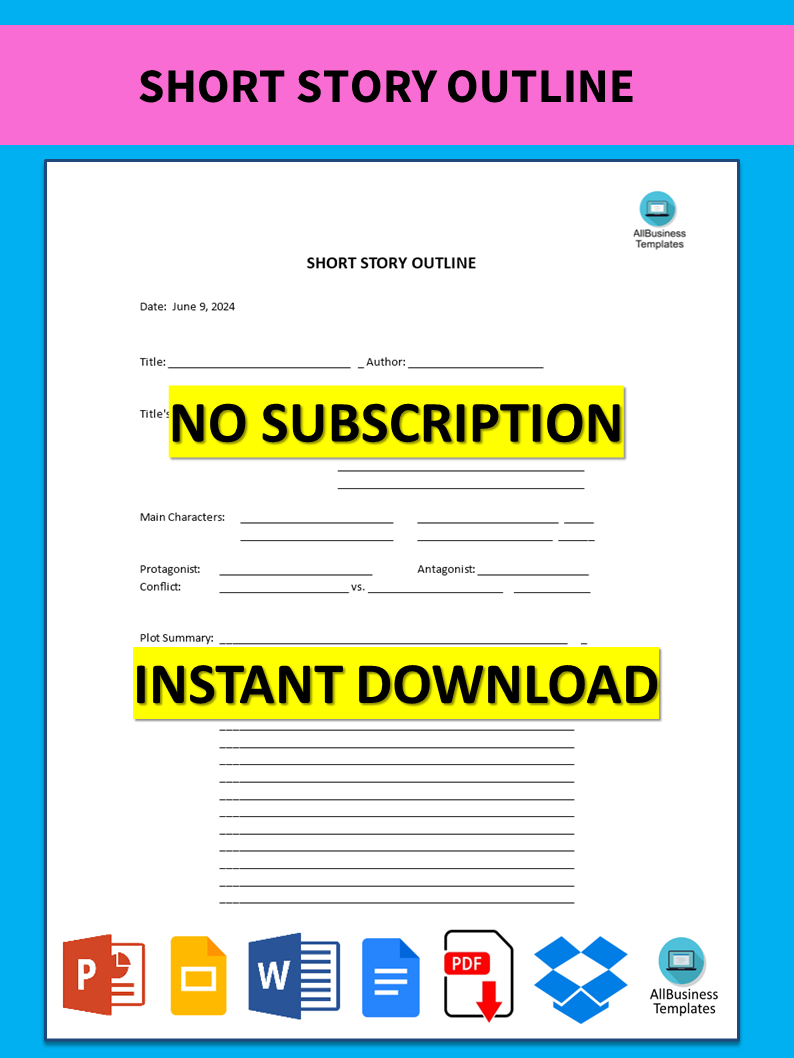Short Story Outline
Save, fill-In The Blanks, Print, Done!

Download Short Story Outline
Microsoft Word (.docx)Or select the format you want and we convert it for you for free:
- This Document Has Been Certified by a Professional
- 100% customizable
- This is a digital download (64.41 kB)
- Language: English
- We recommend downloading this file onto your computer.
How to write a Short Story outline? Do you need a template for an outline of a short story? This template can help you create a well-structured story with a clear beginning, middle, and end. It can also serve as a useful tool to help you brainstorm ideas and plan your writing.
When you are writing a short story, it's a good strategy to start planning its outline. Although a short story can be much looser in its structure and up for a lot of interpretation with loose ends, it's useful to follow a classic structure for guidance. Even if you're writing a more structureless story. This short story outline covers the most important topics that you are looking for and will help you to structure and communicate professionally with those involved.
A storyboard doesn't have to be an elaborate work of art. Here is how to make one:
- Download and modify a Story template: Draw a series of rectangles on a piece of paper, as if you were creating a comic strip, and also leave room for notes or lines of the script under each rectangle.
- Add the script: under each rectangle, write the line of script or dialogue that corresponds to that scene.
- Sketch out an interesting story: indicate movement with an arrow of basic figures. A bad drawing is better than no drawing! Alternatively, you may use existing images and paste them into the story.
- title's meaning
- main characters
- protagonist
- antagonist
- conflict
- intensify conflict
- plot summary
Finally, don't be too cautious about your story
- Take some chances.
- Ok to draw quickly and sloppily in the beginning, especially if you feel inspired and need to get your ideas down on paper.
- Go back and forth, and work on your storyboards.
- Have fun with your storyboards, they're the perfect tool for letting your imagination work.
- Here are a few more storyboarding tips:
- Use rectangles that are the same aspect ratio as the video, 16:9.
- Number each rectangle for easy reference in discussions.
- Bone up on the standard shot types used in the video before you start.
- Think in 3D. Make subjects/objects in the background smaller, so they appear further away.
- Cut up and recombine your storyboards to play with sequencing and narrative.
- Use the finished storyboard to create a master shot list. This way nothing will get overlooked during production.
- Keep the storyboard simple so it can be understood by anyone who views it,
- Be sure to share the finished product with everyone involved after its final cut!
Feel free to download this intuitive template which is available in several kinds of formats, or try any other of our basic or advanced templates, forms, or documents. Don't reinvent the wheel every time you start something new...
You can open the template in Google Docs or download it as a Word template to enhance efficiency! You'll succeed in delivering a well-structured and efficient story outline.
DISCLAIMER
Nothing on this site shall be considered legal advice and no attorney-client relationship is established.
Leave a Reply. If you have any questions or remarks, feel free to post them below.
Related templates
Latest templates
Latest topics
- GDPR Compliance Templates
What do you need to become GDPR compliant? Are you looking for useful GDPR document templates to make you compliant? All these compliance documents will be available to download instantly... - Google Docs Templates
How to create documents in Google Docs? We provide Google Docs compatible template and these are the reasons why it's useful to work with Google Docs... - IT Security Standards Kit
What are IT Security Standards? Check out our collection of this newly updated IT Security Kit Standard templates, including policies, controls, processes, checklists, procedures and other documents. - Letter Format
How to format a letter? Here is a brief overview of common letter formats and templates in USA and UK and get inspirited immediately! - Google Sheets Templates
How to work with Google Sheets templates? Where to download useful Google Sheets templates? Check out our samples here.
cheese

